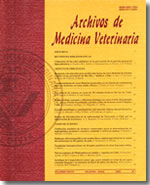Leptospirosis in high risk groups of workers from fifteen piggeries and the central abbatoir in Manizales, Colombia
Main Article Content
Abstract
Leptospirosis is a transmissible infectious disease of high prevalence in the bovine and porcine species, reason why it is assumed that prevalence of leptospire infection in risk people is also high. This work was carried out with workers from fifteen piggeries, and from a bovines and porcines abbatoir. The workers were bled thrice with two months intervals, to get leptospirosis point prevalence by the Microagglutination test (MAT) 1:50, and growth inhibition test ((GIT) 1:25. Additionally, urine samples were taken for dark field (DF) examination and cultivation. The serological prevalences identified with MAT were low, higher with GIT, and even higher with the dark field examination and urine cultivation. The last technique (urine cultivation) is most reliable for diagnosis, while MAT detects acute infections, but is not adequate to detect chronic infections. The serovar hardjopratjino was the most frequently found in both groups of workers and while abbatoir workers were positives for the serovars: pomona, grippotyphosa, bratislava and hardjobovis, those from the piggeries were positives to canicola and icterrohaemorragiae. This last serovar was not found in abbatoir workers. conclude, the knowledge on human leptospirosis is still very poor in high risk workers, and the disease might be a non recognized public health problem.

